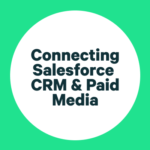BLOG
Connecting Salesforce CRM & Paid Media
Data from both paid media channels and CRM platforms are invaluable tools for any marketer. And there was once a time when these two data sets remained completely separate silos, making it impossible to track and attribute certain conversions.
Now, you can integrate CRM platforms like Salesforce with your paid media channels – Google Ads, Facebook and LinkedIn. This not only makes our lives easier as marketers, it also helps us improve our keyword conversion and get the most bang for our buck. Here, we’ll look at how Salesforce and paid media integration works and why you need to use it.
Get more out of paid media channels
While paid media channels are incredibly valuable tools for marketers, the insights to be gained with the right data management and reporting can be invaluable. Not only can you understand which ads or keywords are driving success within a platform, you can see at a glance where your converting leads are coming from on the whole.
Salesforce and paid media integration gives you new insights and analysis that will help you to achieve your aims of lead conversion. Through integration, you’ll discover where your opportunities are coming from – starting at a platform level, down to individual ads or keywords – and how to optimise your spend moving forward.
But first, we’ll dive deeper into what it means to integrate your CRM and paid media platforms, and why you’ll want to do it.
What does Salesforce integration mean?
You’re using paid media channels to generate leads for your business. You’re also using Salesforce to track the status of these leads as they move through your funnel. Integrating the two allows you to link the conversions you’re already tracking in Salesforce with Google Ads or Facebook, to get an insight into the strengths of your paid media strategy.
To integrate Salesforce with Facebook, you can either follow the prompts within Events Manager (under ‘Partner Integrations’) or reach out to Salesforce directly. For your Google Ads, while it will require a little more legwork, you can get this integration up and running on your own.
Once you’ve set up your Google Ads integration, your website will create a unique ‘Google Click I.D.’ (GCLID) for every time someone clicks through from an ad. If this person then submits a lead form on your site, the GCLID will be passed along to Salesforce and stored with the lead.
If this lead then converts, you’ll be able to track which Ad resulted in the conversion from Google Ads as the data is shared with Salesforce.
Facebook integration works in a similar way – from your Ads Manager dashboard, you will be able to see ‘offline conversions’ that allow you to compare the number of leads an ad generates to the number of these leads who eventually convert. Facebook will then give you the added bonus of being able to create lookalike audiences from the leads who have fully progressed through the funnel.
Your accounts can be configured to track any conversion or opportunity status that you’re already tracking in Salesforce, giving you a new level of transparency into how your ads are pushing leads through your funnel and driving conversions.
Why you need to integrate
As part of your marketing strategy, it’s helpful to know the return-on-investment (ROI) of all of your campaigns, down to individual ad groups, ads and keywords. With Salesforce Google Ads and Facebook integration, you get better insight into how your marketing is generating revenue across all platforms on a more granular level.
Armed with this valuable data, you’d be able to see which keywords or creative work, and which don’t – allowing you to test and optimise for the highest conversion.
Within Google, for example, you may have already noticed that two keywords are driving the majority of your leads – but integration can reveal if one of these keywords has more conversion power down the funnel. Knowing if one is converting significantly stronger than the other, you can then research new keywords in this area to increase your conversion across the board.
You’ll also likely notice a decrease in cost per lead, as you’ll now have the knowledge of which keywords to increase bids on as well as which ones to pause if they’re leading to clicks but not conversions.
The same goes for creative in Facebook, in that you can weed out any ads that may be driving a lot of leads initially, who drop off as they proceed through your funnel.
Salesforce integration in practice: Builders Academy Australia
Social Garden has been working with the team at Builders Academy Australia (BAA) – lead by CEO, Andrew Shea, and National Sales Manager, Ali Musai, for the past few years.
For BAA, providing leads to the sales team is important. But being able to tell which leads are most likely to convert, what the source of each lead is, and the messaging of the ad that brought them in, is even more valuable. It allows the sales team to personalise the conversations with each individual lead, and provide a more personalised experience to prospective students.
With BAA’s Salesforce integration offering transparency into which ads are driving leads and registrations into their courses, we were keen to set-up dashboards and reporting structures that showed us what was occuring.
We waited eagerly to see what insights the integration would yield – and it was even better than we’d anticipated. Approximately 80% of registrations were being impacted by our paid media or email marketing campaigns.
After running for a couple of weeks, we were able to see which channels were strong lead generators, which channels were converting, what the cost-per-registration was, and where we should be allocating budget for the best return on investment.
We could also identify which ad groups were delivering registrations, and optimised the ad budgets and further built out these campaigns accordingly.
From here, these leads were brought into a nurture sequence in our automation platform, Marketo – also integrated with Salesforce. Knowing which messaging in the ads leads to registrations down the funnel allowed us to craft every email in the nurture series to expand on these key messages and increase conversion rates.
Since this initial integration, we’ve been able to integrate Salesforce CRM, Marketo, Facebook, Instagram, Snapchat, LinkedIn & Google data to provide a holistic view of the performance of all marketing activities on a cost-per-enrolment basis.
The insights we’ve gathered from this data has given both Social Garden & BAA a better view of the optimal media investment mix, which has resulted in a reduction in the cost-per-registration since its implementation.
Pulling it all together
As marketers, we have a wealth of data at our fingertips – but knowing how to interpret and harness the power of this data is what will set your campaigns apart from the rest. It’s your quality data and reporting that helps you to understand which campaigns to keep, which to tweak, and which to ditch.
Your aim is to identify the highest quality leads and convert them. By integrating your customer relationship manager and your paid media channels, you can focus your analysis and reporting on targeting those high quality leads.
At the end of the day, our tools and technologies should be working towards optimising ad spend, getting the best return-on-investment, and maximising profits. That’s what Salesforce and paid media integration is all about.













